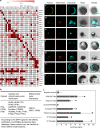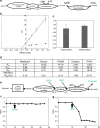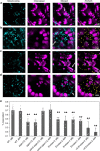A moonlighting role for enzymes of glycolysis in the co-localization of mitochondria and chloroplasts
- PMID: 32908151
- PMCID: PMC7481185
- DOI: 10.1038/s41467-020-18234-w
A moonlighting role for enzymes of glycolysis in the co-localization of mitochondria and chloroplasts
Abstract
Glycolysis is one of the primordial pathways of metabolism, playing a pivotal role in energy metabolism and biosynthesis. Glycolytic enzymes are known to form transient multi-enzyme assemblies. Here we examine the wider protein-protein interactions of plant glycolytic enzymes and reveal a moonlighting role for specific glycolytic enzymes in mediating the co-localization of mitochondria and chloroplasts. Knockout mutation of phosphoglycerate mutase or enolase resulted in a significantly reduced association of the two organelles. We provide evidence that phosphoglycerate mutase and enolase form a substrate-channelling metabolon which is part of a larger complex of proteins including pyruvate kinase. These results alongside a range of genetic complementation experiments are discussed in the context of our current understanding of chloroplast-mitochondrial interactions within photosynthetic eukaryotes.
Conflict of interest statement
The authors declare no competing interests.
Figures







Similar articles
-
Metabolite profiling of Arabidopsis mutants of lower glycolysis.Sci Data. 2022 Oct 11;9(1):614. doi: 10.1038/s41597-022-01673-z. Sci Data. 2022. PMID: 36220829 Free PMC article.
-
Enzymes of glycolysis are functionally associated with the mitochondrion in Arabidopsis cells.Plant Cell. 2003 Sep;15(9):2140-51. doi: 10.1105/tpc.012500. Plant Cell. 2003. PMID: 12953116 Free PMC article.
-
Glycolytic enzyme interactions with tubulin and microtubules.Biochim Biophys Acta. 1989 Nov 9;999(1):64-70. doi: 10.1016/0167-4838(89)90031-9. Biochim Biophys Acta. 1989. PMID: 2553125
-
Chemical genetics and its application to moonlighting in glycolytic enzymes.Biochem Soc Trans. 2014 Dec;42(6):1756-61. doi: 10.1042/BST20140201. Biochem Soc Trans. 2014. PMID: 25399602 Review.
-
Red cell glycolytic enzyme disorders caused by mutations: an update.Cardiovasc Hematol Disord Drug Targets. 2009 Jun;9(2):95-106. doi: 10.2174/187152909788488636. Cardiovasc Hematol Disord Drug Targets. 2009. PMID: 19519368 Review.
Cited by
-
Metabolite profiling of Arabidopsis mutants of lower glycolysis.Sci Data. 2022 Oct 11;9(1):614. doi: 10.1038/s41597-022-01673-z. Sci Data. 2022. PMID: 36220829 Free PMC article.
-
Proviral insights of glycolytic enolase in Bamboo mosaic virus replication associated with chloroplasts and mitochondria.Proc Natl Acad Sci U S A. 2025 May 13;122(19):e2415089122. doi: 10.1073/pnas.2415089122. Epub 2025 May 6. Proc Natl Acad Sci U S A. 2025. PMID: 40327700 Free PMC article.
-
ROS-dependent localization of glycolytic enzymes to mitochondria.Redox Biol. 2025 Aug 12;86:103812. doi: 10.1016/j.redox.2025.103812. Online ahead of print. Redox Biol. 2025. PMID: 40803248 Free PMC article.
-
Image-Based Analysis Revealing the Molecular Mechanism of Peroxisome Dynamics in Plants.Front Cell Dev Biol. 2022 May 3;10:883491. doi: 10.3389/fcell.2022.883491. eCollection 2022. Front Cell Dev Biol. 2022. PMID: 35592252 Free PMC article. Review.
-
Metabolic evidence for distinct pyruvate pools inside plant mitochondria.Nat Plants. 2022 Jun;8(6):694-705. doi: 10.1038/s41477-022-01165-3. Epub 2022 Jun 9. Nat Plants. 2022. PMID: 35681019
References
-
- Kohler R. The background to Eduard Buchner’s discovery of cell-free fermentation. J. Hist. Biol. 1971;4:35–61. - PubMed
-
- Plaxton WC. The organization and regulation of plant glycolysis. Annu. Rev. Plant Biol. 1996;47:185–214. - PubMed
-
- Araiza Olivera D, et al. A glycolytic metabolon in Saccharomyces cerevisiae is stabilized by F-actin. FEBS J. 2013;280:3887–3905. - PubMed
Publication types
MeSH terms
Substances
LinkOut - more resources
Full Text Sources
Other Literature Sources
Molecular Biology Databases

